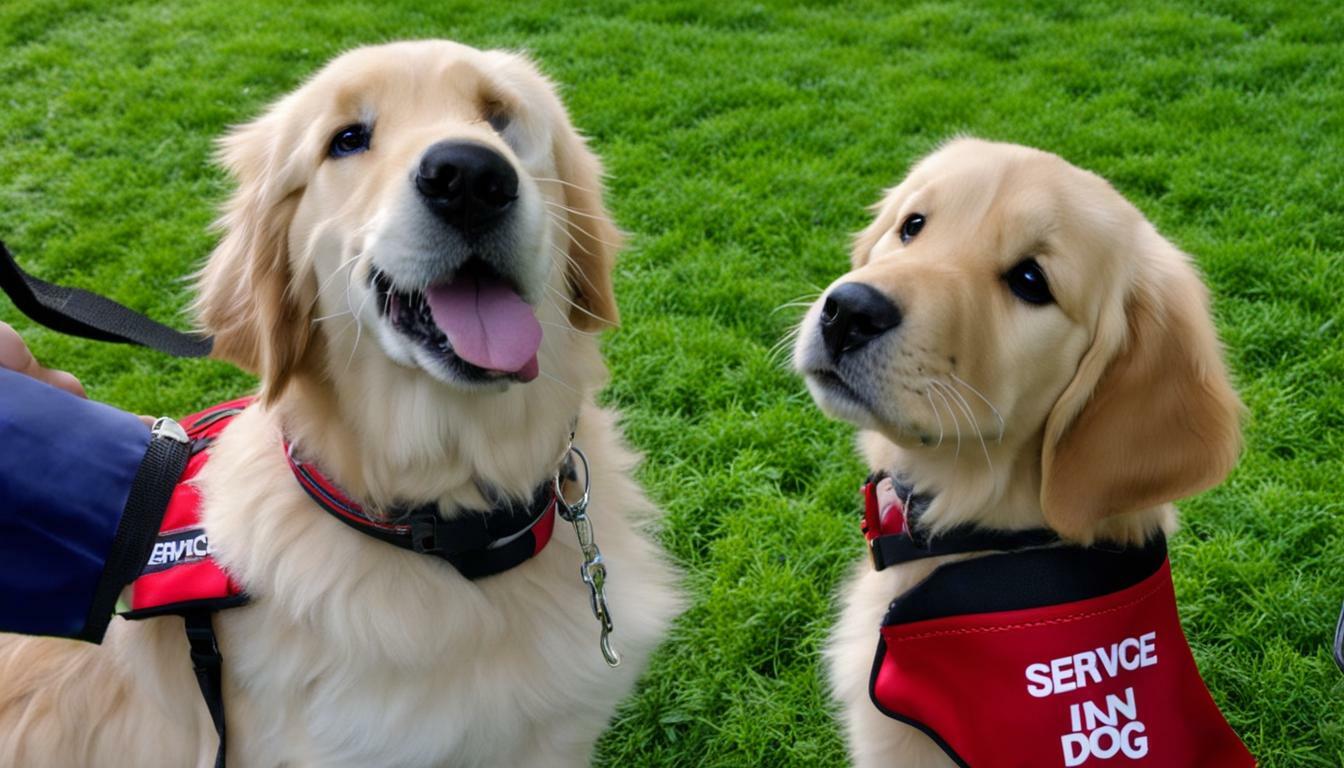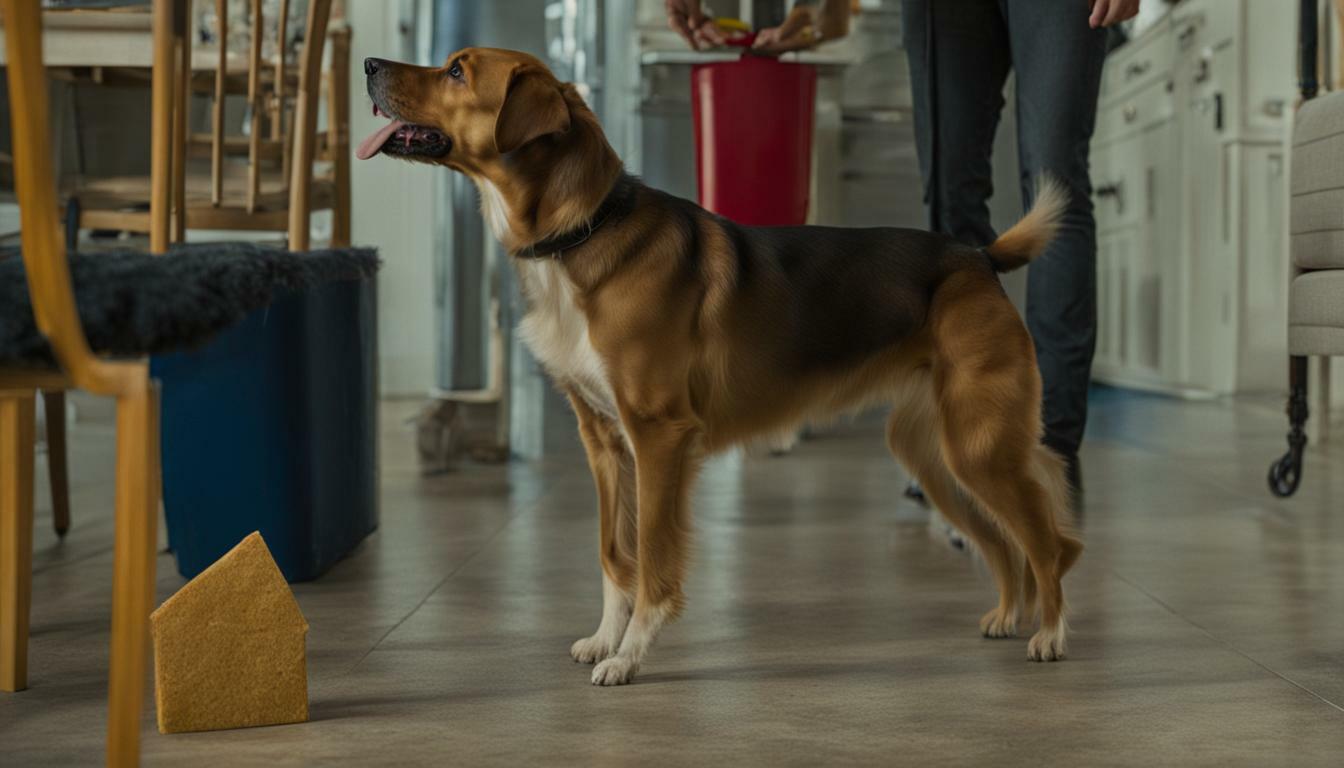Training a Yorkshire Terrier can be a rewarding experience, but it requires patience, consistency, and the right approach. These small dogs are known for their strong-willed temperament, which can make training a challenge. However, with the right techniques and understanding of their behavior, you can successfully train your Yorkshire Terrier to be well-behaved, happy, and healthy.
- Yorkshire Terriers have a strong-willed temperament, making patience key during training.
- Leash training should be done with lightweight harnesses and collars.
- Positive reinforcement, such as rewards and clicker training, is effective in teaching commands.
- Punishment is ineffective and can lead to negative attention.
- Distracting the dog from self-rewarding bad behaviors and Yorkie-proofing the home are important.
Training a Yorkshire Terrier requires consistency in setting boundaries and reinforcing commands. Negative markers can be used to indicate incorrect behavior, but it is important to avoid punishment. Training sessions should be kept brief due to the dog’s short attention span and conducted in areas with few distractions. House training involves consistency, positive reinforcement, and not punishing accidents. Cleaning indoor messes thoroughly and utilizing a crate can aid in house training.
It is important to remember that Yorkshire Terriers have a bold and energetic personality. They require ample exercise and socialization to prevent behavioral issues and maintain a well-rounded disposition. Training and behavior management play a vital role in ensuring a happy and balanced Yorkshire Terrier.
Understanding Yorkshire Terriers: Temperament and Training Challenges
Yorkshire Terriers are small dogs with a strong-willed temperament, making it essential to understand their behavior and train them accordingly. These adorable little dogs can be quick learners, but some may take more time to pick up commands. Patience and consistency are key when training Yorkshire Terriers.
When it comes to leash training, it’s important to use lightweight harnesses and collars to ensure the comfort and safety of your Yorkie. Positive reinforcement is highly effective in teaching commands to these intelligent dogs. Rewards and clicker training can be used to reinforce desired behaviors and encourage obedience.
It’s important to note that punishment is not an effective approach when it comes to training Yorkshire Terriers. Using punishment can result in negative attention and may even worsen behavioral issues. Instead, focus on distracting your Yorkie from self-rewarding bad behaviors and creating a Yorkie-proof home environment to minimize opportunities for undesirable behaviors.
Crate training can be a valuable tool for house training Yorkshire Terriers. It helps establish a routine, provides a safe space for the dog, and aids in preventing accidents. Consistency is crucial in training Yorkshire Terriers and setting clear boundaries. By using negative markers, you can indicate incorrect behavior and redirect your Yorkie towards more desirable actions.
| Training Tips for Yorkshire Terriers: | |
|---|---|
|
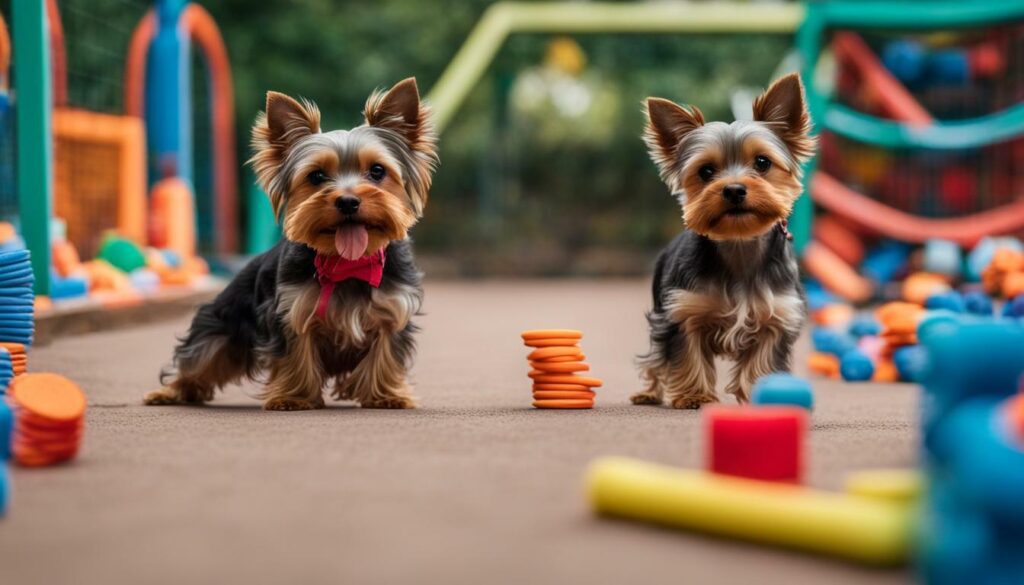 |
Training Yorkshire Terriers can be a rewarding experience when approached with the right techniques and understanding of their unique temperament. By implementing positive reinforcement, consistent training, and creating a stimulating environment, you can ensure that your Yorkie becomes a well-behaved, happy, and healthy companion.
Positive Reinforcement: The Key to Effective Training
Positive reinforcement is a highly effective approach in Yorkshire Terrier training, promoting a harmonious bond between the owner and the dog. This technique involves rewarding desired behaviors, such as following commands or exhibiting good behavior, with treats, praise, or playtime. By associating positive experiences with these behaviors, your Yorkshire Terrier will be motivated to repeat them in the future.
One popular method of positive reinforcement is clicker training. This involves using a small device that makes a distinct clicking sound when pressed. The click is paired with a treat or praise, signaling to the dog that it has done something right. Over time, the click alone becomes a reward in itself, reinforcing the positive behavior.
When using positive reinforcement, consistency is key. Ensure that rewards are given immediately after the desired behavior occurs, so that the association between the behavior and the reward is clear. It’s important to be patient and avoid using punishment, as this can create fear or anxiety in your Yorkshire Terrier and hinder their learning process.
Remember that each dog is unique, and training progress may vary. Be prepared to adjust your training techniques based on your Yorkshire Terrier’s personality and learning style. With patience, consistency, and positive reinforcement, you can effectively train your Yorkshire Terrier to become a well-behaved and obedient companion.

In summary, positive reinforcement is a highly effective approach in Yorkshire Terrier training. By rewarding desired behaviors, such as following commands, with treats or praise, you can motivate your dog to repeat these behaviors. Clicker training is a popular method of positive reinforcement, utilizing a distinct sound to signal a reward. It’s important to be consistent, patient, and avoid punishment when training your Yorkshire Terrier. With the right techniques, you can establish a harmonious bond with your furry friend and ensure their obedience and good behavior.
The Pitfalls of Punishment: Why It Doesn’t Work
Punishment should be avoided in Yorkshire Terrier training, as it can lead to fear, aggression, and other behavioral problems. These small dogs have a strong-willed temperament, and punishment can have adverse effects on their overall well-being. Instead of correcting and redirecting undesirable behaviors, punishment can cause anxiety and stress, making it challenging to build trust and create a positive training environment.
Yorkshire Terriers thrive on positive reinforcement, and punishment contradicts this approach. Rather than focusing on punishment, it is essential to redirect and manage incorrect behaviors through other means. By using positive reinforcement techniques like rewards and clicker training, we can encourage desired behaviors and establish a strong bond with our furry companions.
In addition to the emotional impact, punishment also fails to address the root causes of undesirable behaviors. Yorkshire Terriers often exhibit unwanted behaviors due to boredom, lack of exercise, or unmet socialization needs. By addressing these underlying issues and providing alternative outlets for their energy, we can effectively manage and eliminate problem behaviors without resorting to punishment.
The Importance of Positive Reinforcement in Yorkshire Terrier Training
Positive reinforcement is a powerful tool in training Yorkshire Terriers. By rewarding desired behaviors and ignoring or redirecting unwanted behaviors, we can shape their behavior in a way that is both effective and humane. This approach not only helps to build trust and confidence but also ensures that our Yorkies are motivated to learn and eager to please.
| Benefits of Positive Reinforcement | Examples |
|---|---|
| Increased motivation to learn | Using treats, praise, or play as rewards for good behavior |
| Stronger bond between owner and dog | Providing affection and attention for desired behaviors |
| Improved obedience and responsiveness | Using clicker training to associate a sound with positive reinforcement |
By consistently using positive reinforcement techniques, we can effectively train Yorkshire Terriers while fostering a loving and caring relationship. This approach not only helps to prevent behavioral problems but also promotes a happy, well-behaved, and well-rounded Yorkie.

Distracting and Yorkie-Proofing: Managing Undesirable Behaviors
Yorkshire Terriers can exhibit certain undesirable behaviors, but with proper training techniques, these can be effectively managed and redirected. One effective strategy is to distract the dog from self-rewarding bad behaviors. For example, if your Yorkie starts barking excessively, redirect its attention by offering a treat or a favorite toy. This helps to shift their focus onto a more positive and desired behavior.
Another important aspect of managing undesirable behaviors is to Yorkie-proof your home. Yorkies are known for their curious nature, and it’s crucial to create a safe and stimulating environment for them. Make sure to secure any hazardous items or potentially dangerous areas in your home. Additionally, provide plenty of toys and activities to keep their minds engaged and prevent boredom, which can lead to destructive behaviors.
Here is a table summarizing the key strategies for managing and redirecting undesirable behaviors in Yorkshire Terriers:
| Strategy | Explanation |
|---|---|
| Distract | Redirect the dog’s attention to a more positive behavior using treats or toys |
| Yorkie-proof | Create a safe environment by securing hazardous items and providing engaging toys and activities |
Additional Tips for Managing Undesirable Behaviors:
- Consistency is key. Be consistent in your training techniques and responses to undesirable behaviors. This helps your Yorkie understand what is expected of them.
- Use positive reinforcement. Reward good behavior with praise, treats, or playtime to encourage your Yorkie to repeat those behaviors.
- Avoid punishment. Punishment can lead to fear or aggression in Yorkies, making their behaviors worse instead of better. Focus on positive reinforcement instead.
By implementing these strategies and tips, you can effectively manage and redirect undesirable behaviors in your Yorkshire Terrier, creating a harmonious and well-behaved pet.

Note: The image above demonstrates an example of proper Yorkshire Terrier behavior training.
Crate Training: A Valuable Tool for House Training
Crate training can be a valuable tool in the process of house training a Yorkshire Terrier, promoting both security and cleanliness. Yorkshire Terriers are small dogs with a strong-willed temperament, making consistent and effective training essential. By introducing crate training early on, you can establish a routine and provide your Yorkie with a designated space to call their own.
When crate training your Yorkshire Terrier puppy, it’s important to choose a crate that is appropriately sized to create a cozy and secure environment. A crate that is too large may lead to accidents, while one that is too small will cause discomfort. Ensure that your Yorkie has enough space to stand, turn around, and lie down comfortably.
During the house training process, utilize the crate as a tool to manage your Yorkie’s behavior and prevent accidents. Incorporate positive reinforcement techniques, such as treats and praise, to create a positive association with the crate. Gradually increase the amount of time your Yorkie spends in the crate, always keeping it a pleasant and safe space.

Crate training offers numerous benefits for Yorkshire Terriers and their owners. Not only does it provide a secure space for your Yorkie, but it also aids in the house training process. By confining your Yorkie to the crate when you cannot supervise them, you can prevent accidents and establish a routine for bathroom breaks. Additionally, crate training promotes a sense of security and can help alleviate separation anxiety in Yorkshire Terriers, as they have a designated space where they feel safe and comfortable.
| Benefits of Crate Training for Yorkshire Terriers: |
|---|
| 1. Security and comfort |
| 2. Aid in house training process |
| 3. Alleviate separation anxiety |
| 4. Provides a designated space |
Consistency and Boundaries: The Keys to Success
Consistency is crucial in Yorkshire Terrier training, providing a solid foundation for desired behaviors and establishing a harmonious relationship. Yorkies have a strong-willed temperament, and maintaining consistent training methods and boundaries will help them understand what is expected of them. Whether teaching basic commands or addressing behavioral issues, consistent reinforcement of training commands and expectations will lead to successful outcomes.
When training your Yorkshire Terrier, it is important to set clear boundaries from the start. Establishing rules and consistently reinforcing them will help your Yorkie understand what is acceptable behavior. For example, if you don’t want your Yorkie to jump on furniture, be sure to consistently redirect them to their own designated spot. Reinforcing these boundaries with positive reinforcement will ensure your Yorkie learns the appropriate behaviors and avoids confusion.
To maintain consistency in training, it is important to have a structured routine. Set aside short, focused training sessions to work on specific commands or behaviors. Breaking down training into smaller, achievable goals will keep your Yorkie engaged and prevent them from becoming overwhelmed. Remember, Yorkshire Terriers have short attention spans, so keeping training sessions brief and frequent is key to their success.
Additionally, consistency in your tone of voice and body language is essential. Deliver commands in a clear and confident manner, using the same words and gestures each time. By doing so, your Yorkie will become familiar with your cues and respond accordingly. Consistency in your training approach will foster a stronger bond between you and your Yorkshire Terrier, leading to a more obedient and well-behaved pet.
| Key Points | Summary |
|---|---|
| Consistency | Consistency is crucial in Yorkshire Terrier training, providing a solid foundation for desired behaviors and establishing a harmonious relationship. |
| Boundaries | Setting clear boundaries and consistently reinforcing them will help your Yorkie understand what is acceptable behavior. |
| Routine | Having a structured routine with short, focused training sessions will keep your Yorkie engaged and prevent them from becoming overwhelmed. |
| Tone and Body Language | Consistency in your tone of voice and body language will help your Yorkie understand your cues and respond accordingly. |
By maintaining consistency and setting clear boundaries in your Yorkshire Terrier’s training, you are creating an environment where they can thrive. Consistent reinforcement of training commands, incorporating positive reinforcement, and establishing a structured routine will ensure a well-behaved and happy Yorkie. Remember to remain patient and persistent, as training takes time and effort. With consistency and dedication, you can master the basics of Yorkshire Terrier training and enjoy a strong and rewarding relationship with your furry friend.

Negative markers can be a useful tool in Yorkshire Terrier training, helping to correct and redirect behaviors that are not desired. These markers act as a clear signal to the dog that their current behavior is incorrect, allowing you to guide them towards more appropriate actions. When used correctly, negative markers can effectively reinforce boundaries and shape desired behaviors in your Yorkie.
One commonly used negative marker is the word “no.” This simple and straightforward word can be spoken firmly and assertively to indicate to your dog that their behavior is unacceptable. It is important to use a consistent tone and keep the word “no” associated solely with negative behaviors. This way, your Yorkshire Terrier will quickly learn to associate the word with the correction, making it easier for them to understand and adjust their behavior.
When using negative markers, it is crucial to pair them with positive reinforcement. Instead of solely focusing on what your Yorkie is doing wrong, make sure to reward and praise them for correct behavior. This positive reinforcement encourages your dog to repeat the desired actions and reinforces the idea that good behavior leads to positive outcomes.
Remember that timing is key when using negative markers. It is important to deliver the marker immediately after the undesired behavior occurs, so your Yorkie can make the association between the two. Avoid using physical punishment or harsh methods, as they can cause fear and anxiety in your dog, leading to more behavioral problems in the long run.
| Positive Reinforcement | Negative Markers |
|---|---|
| Use rewards and praise to reinforce desired behaviors. | Use a clear and assertive negative marker like “no” to indicate incorrect behavior. |
| Rewards can include treats, toys, or affection. | Pair negative markers with positive reinforcement to guide your Yorkie towards correct behavior. |
| Positive reinforcement can motivate and encourage your dog to repeat the desired actions. | Timing is crucial when using negative markers to ensure your Yorkie understands the correction. |
By combining negative markers with positive reinforcement, you can effectively correct and redirect incorrect behaviors in your Yorkshire Terrier. Consistency, patience, and a clear understanding of your dog’s needs are key to successful training. With time and practice, your Yorkie will learn to respond to these markers, leading to a well-behaved and happy companion.
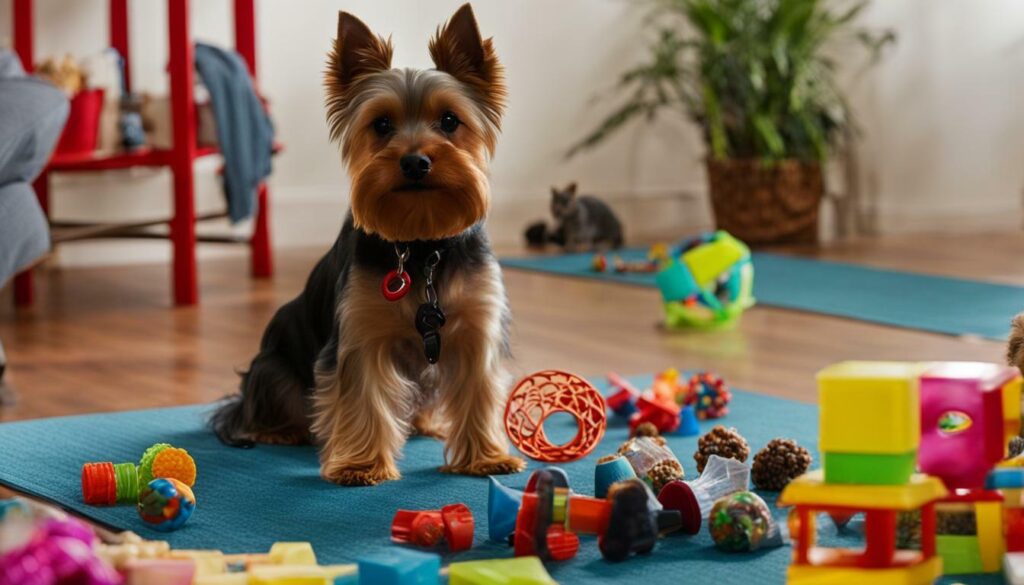
Training sessions for Yorkshire Terriers should be kept short and engaging to ensure maximum focus and learning. These small and energetic dogs have a relatively short attention span, so it’s important to make the most of their training sessions. By following a few key tips, you can create effective training sessions that yield positive results.
Firstly, it’s important to establish a structured routine for training sessions. Set aside dedicated time each day for training and stick to a consistent schedule. This helps your Yorkshire Terrier understand when to expect training and creates a sense of predictability.
To keep your Yorkie engaged, make training sessions fun and rewarding. Use a variety of training methods, such as incorporating treats, toys, and praise as positive reinforcements. By using positive reinforcement, you can motivate your dog to learn and respond to commands eagerly.
Another important aspect of training sessions is to keep them brief. Aim for short, focused sessions that last no more than 10 to 15 minutes. Yorkies can become easily distracted, so keeping the sessions short prevents them from losing interest or becoming overwhelmed. Remember, quality over quantity is key.
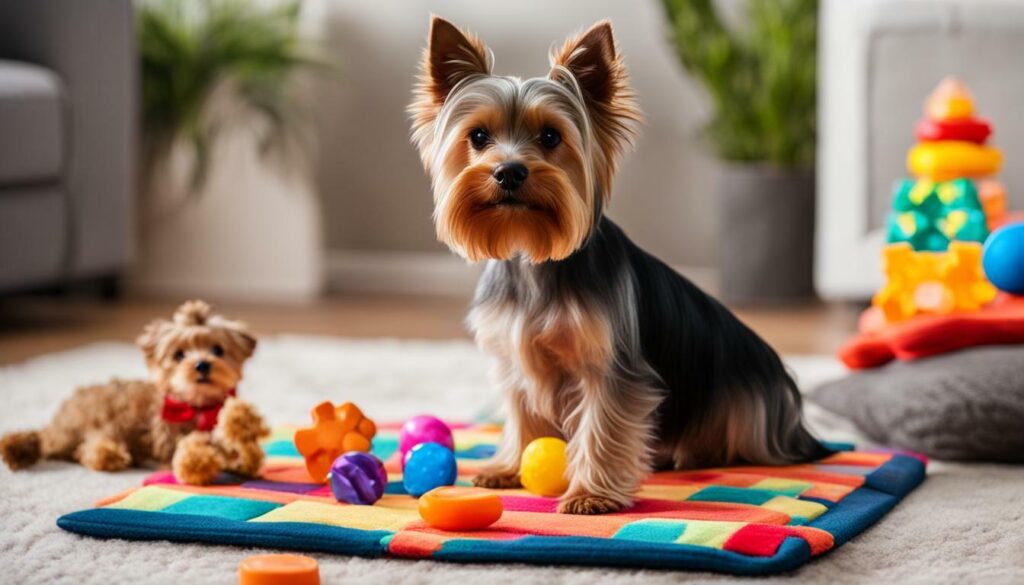
In summary, training sessions for Yorkshire Terriers should be kept short, engaging, and consistent. By following a structured routine, incorporating positive reinforcement, and keeping sessions brief, you can maximize your Yorkie’s focus and learning potential. With patience and dedication, your Yorkshire Terrier will master the basics and become a well-trained and obedient companion.
| Tips for Effective Training Sessions |
|---|
| Establish a structured routine and stick to a consistent schedule for training sessions. |
| Make training sessions fun and rewarding by using treats, toys, and praise as positive reinforcements. |
| Keep training sessions brief, aiming for 10 to 15 minutes of focused training at a time. |
Exercise and Socialization: Essential for a Well-Rounded Yorkie
Exercise and socialization are crucial aspects of Yorkshire Terrier training, contributing to their overall well-being and balanced temperament. These small dogs have a bold and energetic personality, requiring ample physical activity and opportunities for social interaction.
Regular exercise is essential for keeping your Yorkie happy and healthy. Daily walks or play sessions provide an outlet for their energy, preventing boredom and destructive behaviors. Lightweight harnesses and collars should be used for leash training to ensure their comfort and safety.
Additionally, socialization plays a vital role in shaping your Yorkie’s behavior. Exposing them to different people, animals, and environments from a young age helps them develop confidence and adaptability. Gradually introduce them to new experiences, such as meeting other dogs in controlled settings or taking them to dog-friendly parks, to foster positive social interactions.
Training and behavior management are integral parts of socialization. Positive reinforcement, such as rewards and clicker training, is effective in teaching commands and encouraging desired behaviors. Punishment, on the other hand, can have negative consequences and may lead to anxiety or aggression in your Yorkie.
By prioritizing exercise, socialization, and positive reinforcement in your training approach, you can ensure your Yorkshire Terrier grows into a well-rounded and well-behaved companion. Remember to be patient and consistent, and seek guidance from professional trainers if needed. With the right training techniques and plenty of love and care, your Yorkie will thrive and bring joy to your life.
FAQ
Q: What training techniques work best for Yorkshire Terriers?
A: For Yorkshire Terriers, positive reinforcement techniques such as rewards and clicker training are effective in teaching commands and encouraging desired behaviors.
Q: Is punishment a good approach in Yorkshire Terrier training?
A: No, punishment is ineffective and can lead to negative attention. It is best to focus on positive reinforcement and alternative approaches to address behavioral issues.
Q: How can I manage undesirable behaviors in my Yorkie?
A: Distracting the dog from self-rewarding bad behaviors and creating a Yorkie-proof home environment are essential strategies for managing and redirecting undesirable behaviors.
Q: Can crate training help with house training a Yorkshire Terrier?
A: Yes, crate training can be a valuable tool in house training Yorkshire Terriers. It helps establish a routine and prevent accidents when used properly.
Q: What is the key to successful Yorkshire Terrier training?
A: Consistency is crucial in Yorkshire Terrier training. It is important to set clear boundaries and consistently reinforce training commands to ensure desired behaviors are consistently exhibited.
Q: How can I correct and redirect incorrect behavior in my Yorkie?
A: Negative markers can be used to indicate incorrect behavior in Yorkshire Terrier training. They help correct and redirect undesirable behaviors effectively.
Q: How long should training sessions be for Yorkshire Terriers?
A: Training sessions should be kept brief due to the Yorkshire Terrier’s short attention span. It is important to make the sessions engaging and effective within these shorter durations.
Q: Are exercise and socialization important for Yorkshire Terriers?
A: Yes, exercise and socialization are essential for a well-rounded Yorkie. Incorporating regular exercise and socialization exercises into the training routine is crucial for their overall well-being.
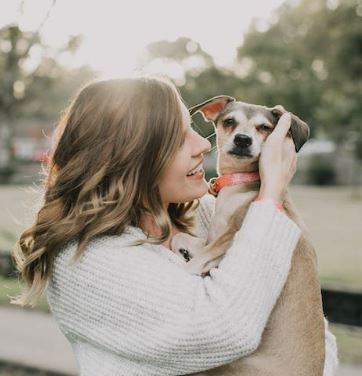
Marissa Delotta, 36, from Dayton, Ohio, is the creative force behind Roverboard.com, a beloved online destination for dog lovers. As a dedicated mom and canine enthusiast, Marissa combines her family experiences with her love for dogs to offer a platform where dog owners can exchange tips, heartwarming stories, and advice. Her website has become a vibrant community for sharing the joys of dog parenting. In her free time, Marissa enjoys exploring dog parks with her family and volunteering at local animal shelters.



